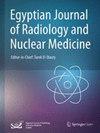Dynamic vertebral artery occlusion aka bow hunter syndrome causing posterior fossa stroke in a young adult: a case report
IF 0.5
Q4 RADIOLOGY, NUCLEAR MEDICINE & MEDICAL IMAGING
Egyptian Journal of Radiology and Nuclear Medicine
Pub Date : 2024-05-07
DOI:10.1186/s43055-024-01265-4
引用次数: 0
Abstract
Bow Hunter syndrome (BHS) is a rare, but important cause of posterior circulation stroke. It is also known as Rotational vertebral artery syndrome and is caused by transient dynamic vertebro-basilar insufficiency on movement of the neck in the presence of certain soft tissue or bone anomalies in the cranio-vertebral region. We present a case of Bow hunter syndrome in an 18-year-old adult male who presented with vomiting, occipital headache and loss of balance, with findings of posterior circulation stroke on imaging. Medical causes of young stroke, including vasculitis and clotting disorders were ruled out, following which a diagnostic conventional angiography and CT angiography was performed. The cause of vascular compromise in our case was the presence of vertebral anomalies, in particular, the presence of a partial ponticulus posticus with formation of an incomplete arcuate foramen. He was treated with cervical spine immobilisation and C1–C2 fixation. In addition, our patient had a single posterior inferior cerebellar artery (PICA) on the side of the dynamic insufficiency, which lead to bilateral cerebellar infarcts. Our case is unique because it demonstrates a combination of osseous and vascular developmental anomalies resulting in posterior circulation stroke. Though uncommon, BHS should be considered in the list of differentials in otherwise unexplained cases of posterior circulation stroke. Conventional angiography with dynamic manoeuvres is the modality of choice for documenting the rotational vertebral artery occlusion.动态椎动脉闭塞又名弓形猎人综合征,导致一名年轻成人后窝中风:病例报告
猎弓综合征(BHS)是后循环中风的一种罕见但重要的病因。它也被称为旋转性椎动脉综合征,是在颅椎区域存在某些软组织或骨骼异常的情况下,颈部运动时出现短暂的动态椎-基底动脉供血不足所致。我们报告了一例鲍-亨特综合征病例,患者为一名 18 岁的成年男性,表现为呕吐、枕部头痛和失去平衡,影像学检查发现为后循环卒中。排除了包括血管炎和凝血障碍在内的年轻中风的医学原因,随后进行了诊断性常规血管造影和 CT 血管造影。我们病例血管受损的原因是存在椎体异常,尤其是存在部分椎体后凸,并形成不完整的弧形孔。他接受了颈椎固定和 C1-C2 固定治疗。此外,我们的患者在动力不足的一侧有一条小脑后下动脉(PICA),这导致了双侧小脑梗死。我们的病例很独特,因为它显示了骨性和血管性发育异常共同导致的后循环中风。虽然不常见,但对于原因不明的后循环卒中病例,应将 BHS 列入鉴别病例的考虑范围。传统的动态血管造影是记录旋转性椎动脉闭塞的首选方式。
本文章由计算机程序翻译,如有差异,请以英文原文为准。
求助全文
约1分钟内获得全文
求助全文
来源期刊

Egyptian Journal of Radiology and Nuclear Medicine
Medicine-Radiology, Nuclear Medicine and Imaging
CiteScore
1.70
自引率
10.00%
发文量
233
审稿时长
27 weeks
 求助内容:
求助内容: 应助结果提醒方式:
应助结果提醒方式:


